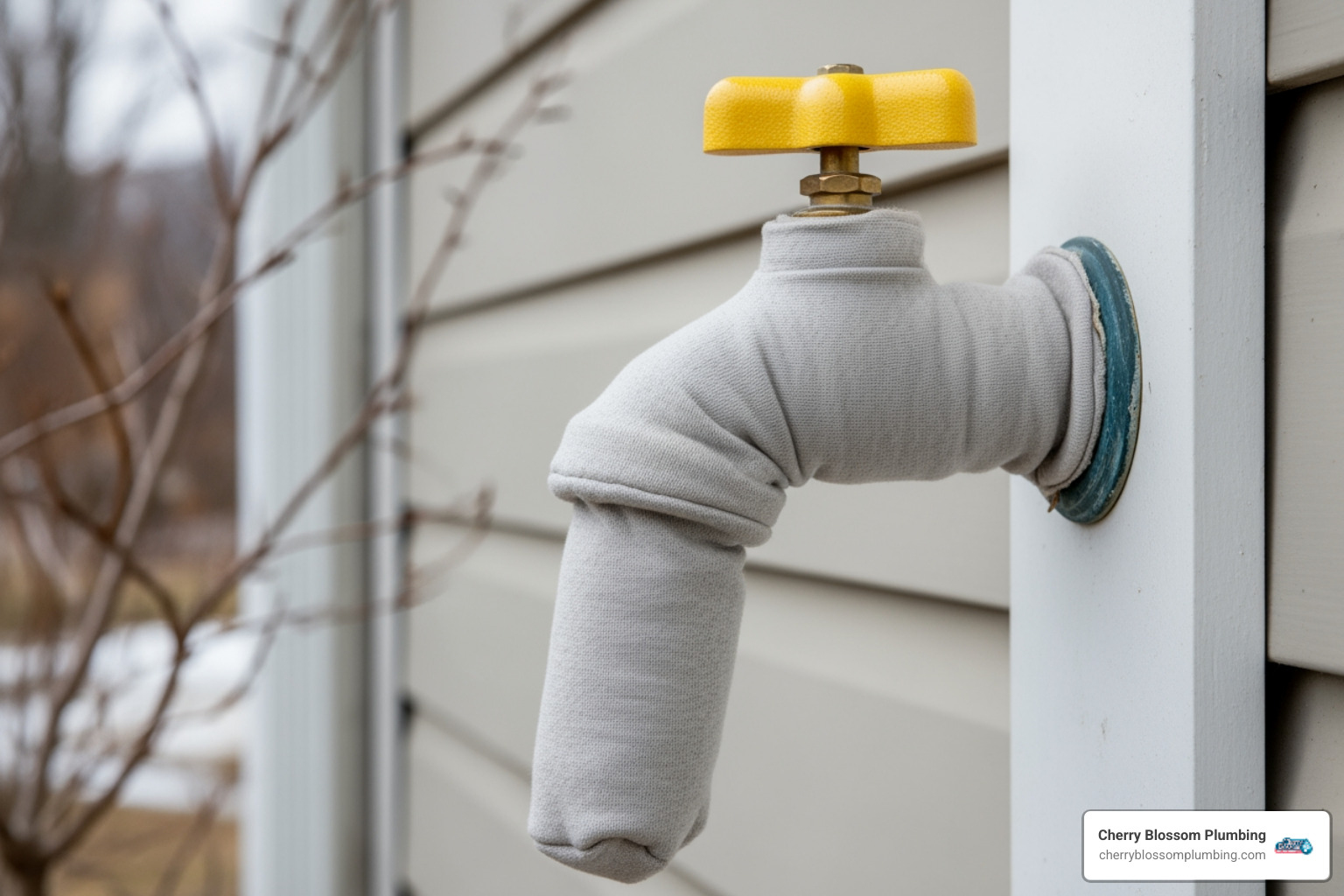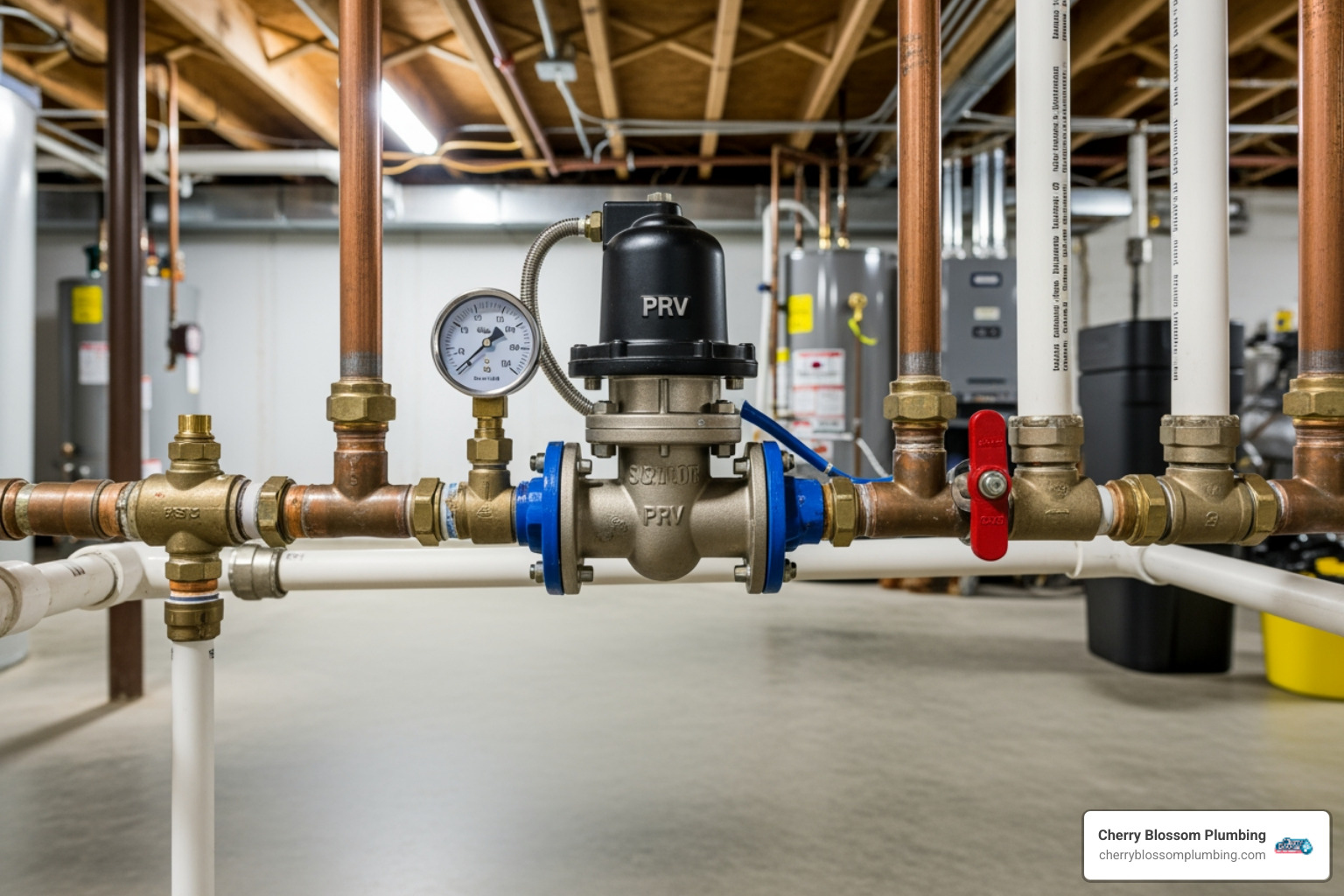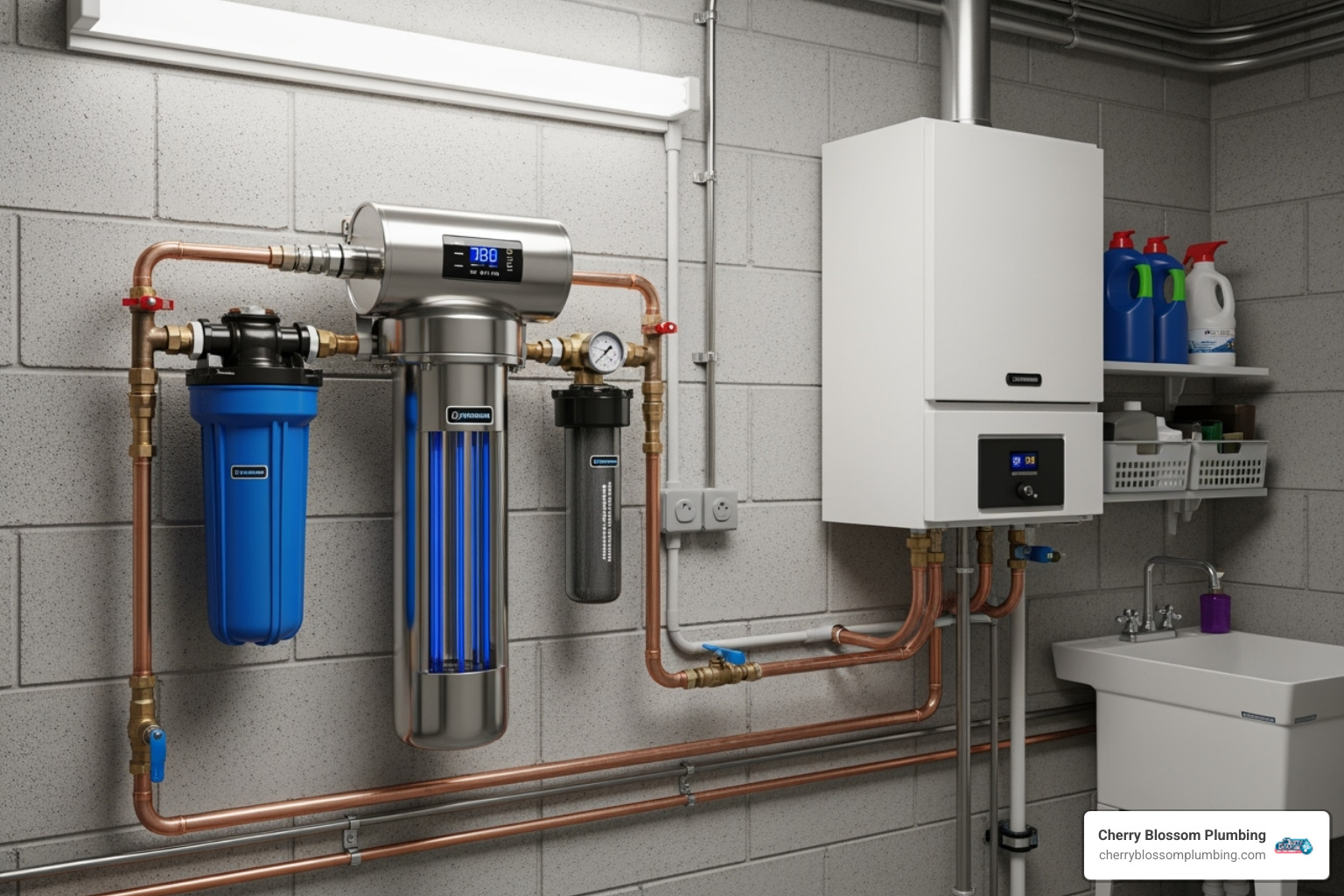
Understanding UV Water Filtration Technology
A uv light water filter uses ultraviolet light to destroy harmful microorganisms in your water without adding chemicals or changing its taste. Here's what you need to know:
How it works:
- UV-C light at 254 nanometers disrupts pathogen DNA
- Prevents bacteria, viruses, and parasites from reproducing
- Destroys 99.99% of disease-causing microbes
What it removes:
- Bacteria (E. coli, Salmonella)
- Viruses (Hepatitis B, Norovirus)
- Parasites (Cryptosporidium, Giardia)
What it doesn't remove:
- Heavy metals or chemicals
- Sediment or dissolved solids
- Taste and odor issues
UV systems are chemical-free, energy-efficient, and provide continuous protection for your home's water. As Amanda Casteel from Cherry Blossom Plumbing, I've seen how uv light water filter systems give Arlington homeowners peace of mind about their water quality. My background in water treatment helps me guide families toward the right filtration solutions for their needs.
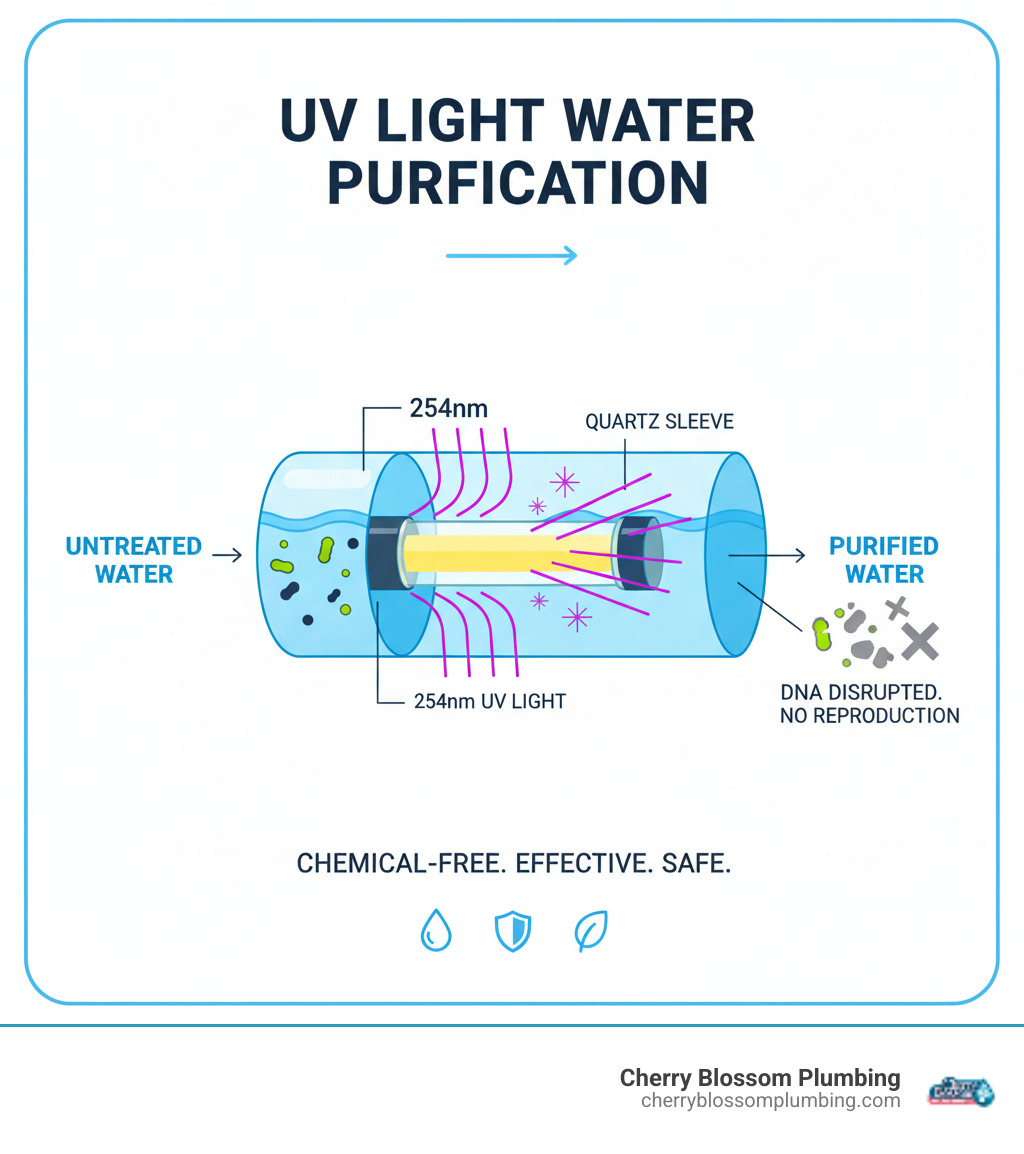
How a UV Light Water Filter Works: The Science of Purification
When water flows through a uv light water filter, it's exposed to a specific wavelength of UV-C light (254 nanometers) in a process called germicidal irradiation. This light is nature's sweet spot for destroying harmful microorganisms.
As bacteria, viruses, and parasites pass the UV light, it penetrates their cell walls and scrambles their DNA and RNA. This damage is irreversible, preventing them from reproducing or causing illness. Scientific research on how UV scrambles DNA confirms how effective this process is. In seconds, UV light renders virtually all microorganisms harmless, making it a highly reliable disinfection method.
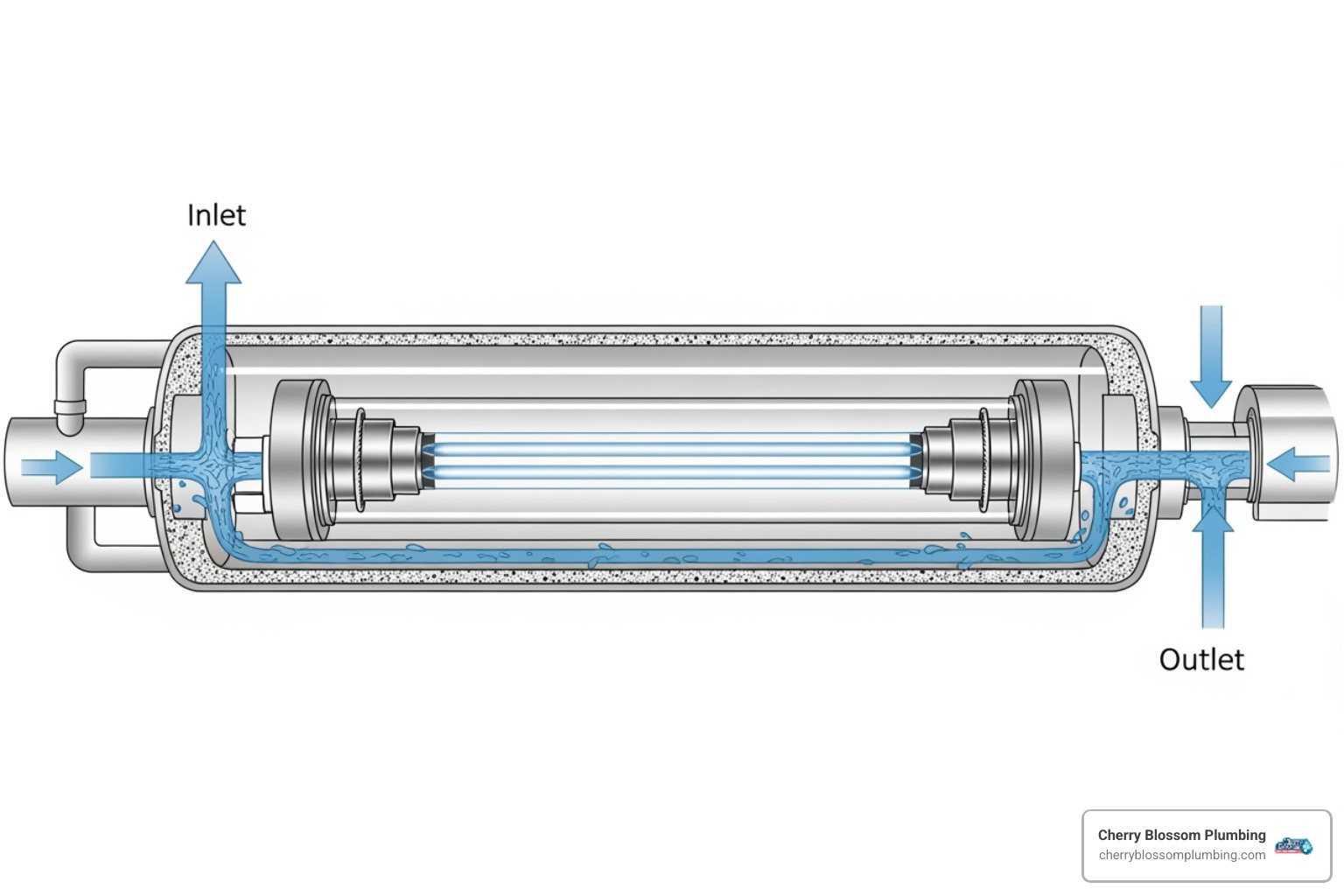
The Core Components of a UV System
A uv light water filter is made of several key parts working together:
The UV Lamp: This specialized bulb generates the germicidal UV-C light. It runs 24/7 and is replaced annually as its intensity fades.
The Quartz Sleeve: A clear glass tube that protects the lamp from water while allowing UV light to pass through freely. Regular glass would block the germicidal rays.
The Stainless Steel Reactor Chamber: This durable housing directs water flow around the quartz sleeve and safely contains the UV light.
The Controller Unit (Ballast): The system's brain, it regulates power to the lamp for optimal UV intensity and often includes alarms for maintenance.
Flow Control: An internal component that ensures water moves through the chamber at the correct speed for complete disinfection, preventing any microbes from slipping by untreated.
What UV Filters Target: A Deep Dive into Contaminants
A uv light water filter is a specialist, targeting living microorganisms that can make your family sick.
UV filtration's strength is its ability to neutralize a wide range of pathogens. Bacteria like E. coli and Salmonella are quickly inactivated. Viruses such as Hepatitis A and Norovirus are also stopped in their tracks as the UV light disrupts their genetic material.
Where UV truly excels is against chlorine-resistant pathogens like Giardia and Cryptosporidium. These parasites have protective shells that allow them to survive traditional chlorine treatment. The 1993 Milwaukee outbreak, where Cryptosporidium in the city's treated water sickened over 400,000 people, was a stark reminder of this vulnerability. UV technology attacks these organisms at their genetic core, where their shells offer no protection. The CDC's information on Cryptosporidium highlights the seriousness of these infections.
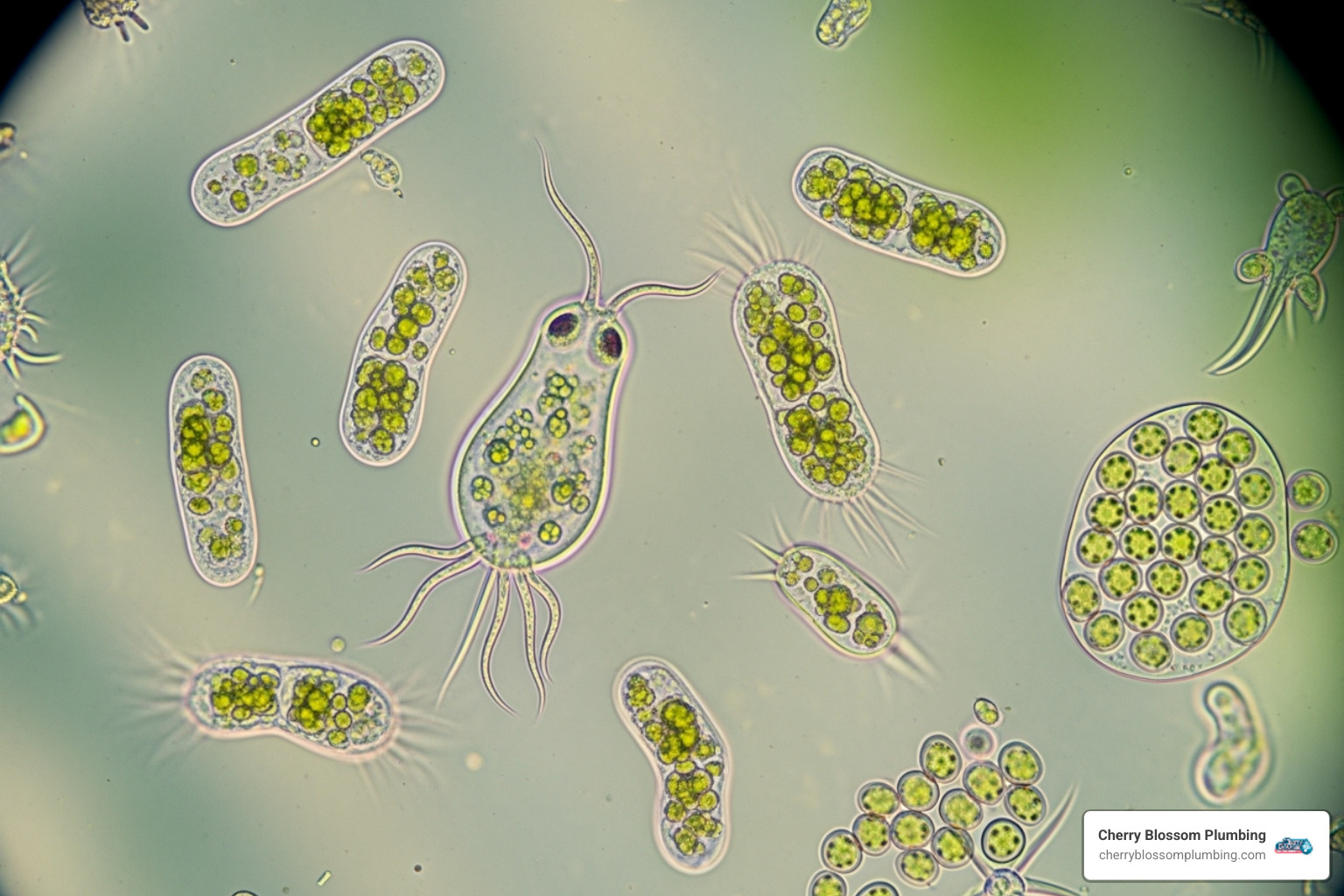
What UV Does Not Remove
It's just as important to understand what a uv light water filter won't do. Since it targets living organisms, it does not remove non-living contaminants. These include:
- Sediment and Turbidity: Particles and cloudiness can shield microbes from UV light, reducing effectiveness.
- Heavy Metals: Lead, mercury, and other metals are unaffected.
- Dissolved Solids: Minerals that cause hard water and salts are not removed.
- Chemicals: Chlorine, pesticides, and industrial solvents pass right through.
- Taste and Odor: These issues, usually caused by chemicals or dissolved compounds, are not addressed by UV.
Understanding these limitations helps in creating a complete water treatment plan, which may require multiple stages if your water has issues beyond microbial contamination.
Pros and Cons: Is UV Filtration Right for Your Home?
Choosing the right water treatment system involves weighing the benefits and drawbacks. A uv light water filter has compelling advantages, but it's not a perfect fit for every situation. At Cherry Blossom Plumbing, we help Arlington and Falls Church homeowners get the complete picture to make the best decision.
The Advantages of UV Purification
- Chemical-Free: UV purification is a physical process. It adds no chemicals to your water, so there are no chemical byproducts or changes to taste and odor.
- Highly Effective: It destroys 99.99% of disease-causing microorganisms, including chlorine-resistant parasites like Cryptosporidium and Giardia.
- Low Maintenance: The primary tasks are an annual lamp replacement and occasional quartz sleeve cleaning. There are no heavy bags or complex chemical schedules.
- Energy Efficient & Eco-Friendly: A typical system uses about as much energy as a 60-watt light bulb and produces no wastewater.
Limitations and Safety Considerations
- Requires Clear Water: UV light is only effective in clear water. Sediment, iron, or other particles can create "shadows" where microbes hide. This is why pre-filtration is almost always necessary.
- Needs Electricity: The system requires a constant power supply to work. During a power outage, your water is not being disinfected.
- No Residual Disinfection: Unlike chlorine, UV only treats water as it passes through the chamber. It does not protect against any contamination that may occur downstream in your pipes.
- Safe Operation: While the UV lamp emits powerful radiation, it is fully enclosed within the stainless steel chamber, posing zero exposure risk during normal operation. Proper precautions are needed only during lamp replacement.
Installing and Maintaining Your UV System
Proper installation is key to a uv light water filter's long-term performance. While some homeowners consider DIY, we recommend professional installation to ensure correct plumbing, electrical work, and integration with other equipment.
Systems can be installed as Point-of-Entry (POE), treating all water entering your home, or Point-of-Use (POU), treating water at a single tap. For either, pre-filtration is not optional—it's essential. UV is the final line of defense, not the first.
- Sediment filters (typically 5-micron) must be installed first to remove particles that can shield microbes from UV light.
- Water softeners are crucial for homes with hard water, common in Northern Virginia. They prevent mineral scale from building up on the quartz sleeve and blocking the UV rays.
Choosing the Right UV Light Water Filter Size
Sizing a uv light water filter correctly depends on your home's flow rate, measured in Gallons Per Minute (GPM). The system must be able to treat all water during periods of peak demand—like when a shower, dishwasher, and toilet are used at once. A simple way to estimate this is by counting bathrooms.
| Number of Bathrooms | Recommended Peak Flow Rate (GPM) | Suggested UV System Size (GPM) |
|---|---|---|
| 1 Bathroom | 5 GPM | 6-8 GPM |
| 2 Bathrooms | 8.5 GPM | 10 GPM |
| 3 Bathrooms | 12 GPM | 12-15 GPM |
| 4 Bathrooms | 15.5 GPM | 15-20 GPM |
| 5 Bathrooms | 19 GPM | 20-25 GPM |
| 6 Bathrooms | 22.5 GPM | 25-30 GPM |
We recommend slightly oversizing the system to ensure complete disinfection even during maximum water use.
Maintenance for Your UV Light Water Filter
Consistent maintenance is simple but vital for keeping your water safe.
- Annual UV Lamp Replacement: UV lamps lose intensity over their 9,000-hour lifespan. Replace the lamp yearly, even if it's still glowing.
- Quartz Sleeve Cleaning: Clean the sleeve every 6-12 months to remove any film or mineral buildup. Replace it every 2-3 years or if it becomes scratched or cloudy.
- Monitor Alarms: Most modern controllers have alarms or countdown timers that alert you when maintenance is due.
- Change Pre-filters: Don't forget the sediment and carbon filters. Clogged pre-filters reduce water pressure and compromise the UV system's effectiveness.
UV vs. Other Disinfection Methods
When choosing a disinfection method, it's helpful to compare a uv light water filter to the most common alternative: chlorination.
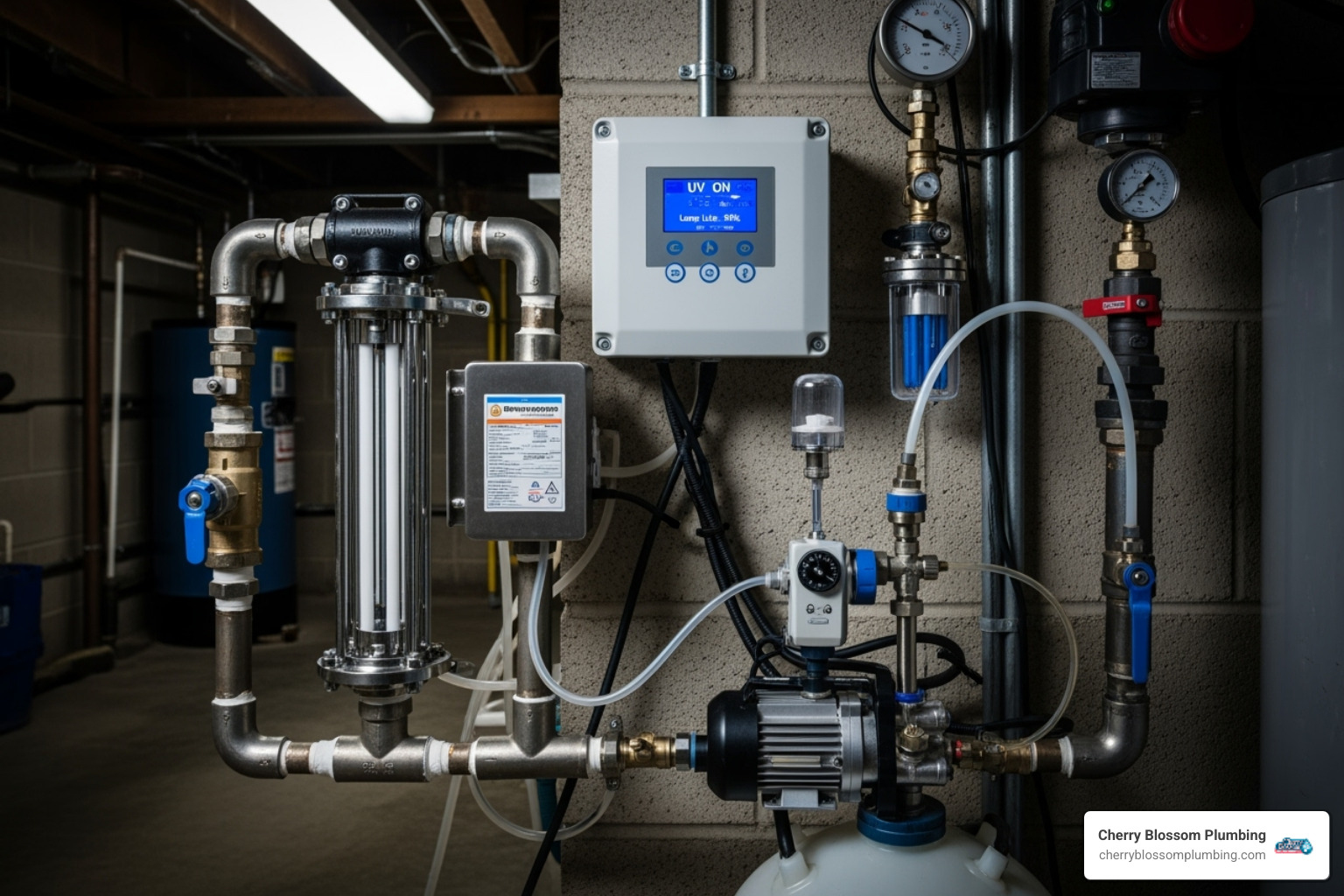
Chlorination has long been the standard for municipal water treatment. It's effective against most bacteria and viruses and provides residual protection as water travels through pipes. However, it has drawbacks that lead many homeowners to seek alternatives.
- Chemicals & Taste: Chlorination adds chemicals, which can create disinfection byproducts (like THMs) and leave an unpleasant taste and odor in the water.
- Pathogen Resistance: Chlorine is less effective against tough parasites like Cryptosporidium and Giardia. The 1993 Milwaukee outbreak, where the chlorine-resistant Cryptosporidium parasite sickened hundreds of thousands, is a stark reminder of this limitation.
UV light disinfection offers a superior alternative for home use. It's a physical process that:
- Adds no chemicals, leaving the water's taste and odor unchanged.
- Is highly effective against chlorine-resistant pathogens, neutralizing them by destroying their DNA.
For homeowners on private wells or those wishing to remove chlorine and its byproducts from city water, a uv light water filter provides powerful, chemical-free protection that addresses the gaps left by traditional chlorination.
Frequently Asked Questions about UV Water Filters
Our customers in Arlington and Falls Church often have great questions about uv light water filter systems. Here are answers to the most common ones.
Do I need a pre-filter for my UV system?
Yes, pre-filtration is essential for a UV system to work correctly. Without it, you may have a false sense of security.
- Sediment filters (5-micron or finer) are needed to remove particles like dirt or rust. These particles can create "shadows" that shield microbes from the UV light, allowing them to pass through untreated.
- Water softeners are recommended for hard water, which is common in Northern Virginia. Hardness minerals can build up on the quartz sleeve, creating a cloudy scale that blocks the germicidal UV rays.
Does a UV system use a lot of electricity?
No, a uv light water filter is very energy-efficient. A typical residential system consumes about the same amount of power as a 60-watt light bulb. This provides continuous, 24/7 protection for your entire home for a very low operational cost.
Can I turn my UV lamp off when I'm not using water?
We strongly recommend against this. UV systems are designed for continuous operation for two key reasons:
- Lamp Lifespan: Frequent on/off cycles can shorten the life of the UV lamp and stress the controller (ballast).
- Safety: Water can be used at any time, even unexpectedly (e.g., an ice maker refilling). If the lamp is off, untreated water will pass into your home's pipes. Leaving the system on ensures every drop is disinfected, providing constant protection.
Conclusion: Ensuring Safe, Pure Water for Your Family
A uv light water filter provides a powerful final barrier against invisible threats in your water supply. By using germicidal light to neutralize bacteria, viruses, and even chlorine-resistant parasites, it ensures your water is microbiologically safe without adding chemicals or altering its taste. This technology offers invaluable peace of mind, whether you're on a private well or want an extra layer of security for your municipal water.
At Cherry Blossom Plumbing, we know that the best solution often involves a comprehensive approach. Combining a UV system with the right pre-filtration creates a complete defense custom to your home's specific water challenges. Our experienced team serves families throughout Northern Virginia, delivering reliable water treatment solutions with our signature "WOW factor."
Ready to take the next step toward purer water for your family? Learn more about our water treatment services and find how we can bring safe, clean water to every faucet in your home.
Customer Testimonials
Cherry Blossom Plumbing has consistently provided top-notch service, ensuring every issue is resolved efficiently and professionally.





